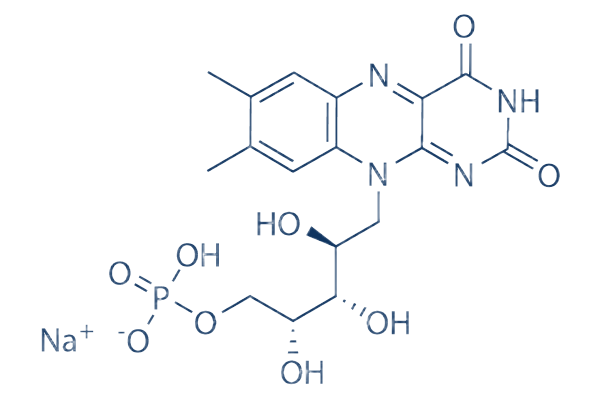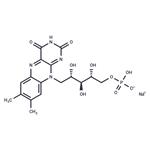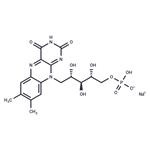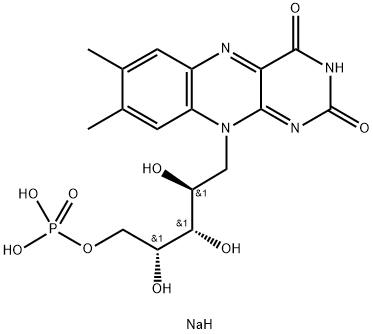What is Riboflavin 5'-Monophosphate Sodium Salt used for?
Jan 15,2024
Introduction of Riboflavin 5'-Monophosphate Sodium Salt
Riboflavin 5'-Monophosphate Sodium Salt is the sodium phosphate salt form of riboflavin, consisting of riboflavin phosphate and vitamin B2. It is functionally related to riboflavin, a water-soluble and essential micronutrient that is the major growth promoter in the natural vitamin B complex.Riboflavin 5'-Monophosphate Sodium Salt can be converted to FMN and FAD, which are essential for the production of energy in the human body and are essential for red blood cell formation and respiration, antibody production, as well as regulating human growth and reproduction. Sodium Riboflavin Phosphate also contributes to human skin health, nail and hair growth. It is also a polymeric photoinitiator and can be used in both acidic and alkaline buffer systems.

Uses of Riboflavin 5'-Monophosphate Sodium Salt
Preparation of pesticide iron detection sensors
A highly sensitive and low-cost optical nanosensor of organic-inorganic hybrid material for pesticide ferbam detection was prepared by utilizing a novel organic siloxane precursor obtained from riboflavin-5′-phosphate sodium salt (Rf). A panel of characterizations was carried out to understand the structure, morphology and surface chemistry of the Rf periodic mesoporous organosilica (Rf-PMO) spherical nanosensors. For the Rf-PMO materials, the doped silica nanoparticles exhibit strong fluorescence emission at 520 nm, on account that the greater steric hindrances and the more separated state of π-conjugate planer platforms between Rf molecules embedded within the silica framework can both enhance the fluorescence emission and reduce the self-quenching of fluorescence produced by stacking aggregation of Rf.
The electron spin resonance (ESR) spectra prove that the prepared Rf-PMO materials can participate in the redox reaction through electron transfer with the pesticide ferbam. Utilized the reducing reaction mechanism of Rf-PMO, it is applied to detect pesticide ferbam with high sensitivity and selectivity, with the limit of detection (LOD) in aqueous solution as low as 6.97 × 10−9 M. Moreover, the X-ray absorption near-edge spectroscopy (XANES) of Fe K-edge shows a coordination structure through the interaction between iron ions from ferbam and O and N atoms in Rf-PMO. X-ray photoelectron spectroscopy (XPS) further reveals the redox mechanism. Therefore, the designed and prepared Rf-PMO is potentially valuable to food safety monitoring involving ferbam as the nanosensor, due to its hypersensitivity and selectivity.
Preparation of thixotropic supramolecular hydrogels
Riboflavin-5'-phosphate sodium salt and adenine can be used to prepare thixotropic supramolecular hydrogels which have enhanced fluorescent properties. An equimolar mixture of riboflavin-5′-phosphate sodium salt (RP) and adenine (AD) dissolved in a phosphate buffer (pH 4.0, 1.0% w/v) produces a red coloured transparent thixotropic hydrogel at 30 °C. The gelation of the RPAD system occurs in the pH range of 2–5. FTIR spectra and WAXS patterns indicate selfassembly via H-bonding between the >CO group of RP and the amino/imino group of AD followed by supramolecular organization through a π-stacking process producing a fibrillar network structure. FESEM images clearly indicate that the nanofibres are produced from the intertwining of helical fibrils.
The dynamic frequency sweep experiment of the supramolecular gel at a constant strain of 1% exhibits a wide linear viscoelastic region and a considerably higher G′ value (460 Pa) than that of G′′ (21 Pa) confirming the gel nature of the RPAD system. The hydrogel shows high stiffness (G′/G′′ = 3.3), a high yield stress (σ*) (79.5 Pa) and a moderate critical strain (γ = 17.5%). Time sweep experiments at both low (0.1%) and high strain (100%) indicate the thixotropic property of the gel. The RPAD hydrogel shows non-Newtonian viscosity in the shear rate region (0.1–158 s) and after that there is a sudden fall of viscosity. The gel melting point obtained by the falling ball method is 6° higher than that obtained by the DSC method probably due to the presence of the thixotropic property of the gel.
The UV-vis spectra indicate a red shift of the π–π* transition band of RP in the RPAD xerogel. On excitation of the RPAD hydrogel at 373 nm it shows twelve times enhancement of emission intensity with a 7 nm red shift of the emission peak. This has been attributed to the enhancement of lifetime from 2.2 ns in RP to 3.4 ns in the RPAD hydrogel. With increase of temperature, the fluorescence intensity of the RPAD hydrogel at first increases till 40 °C, then decreases up to 55 °C and it again increases after 60 °C.
References:
[1] JINGYI LIU . Fabrication and characterization of a novel PMO containing riboflavin-5’-phosphate sodium salt for sensitive detection of pesticide ferbam[J]. Colloids and Surfaces A: Physicochemical and Engineering Aspects, 2021. DOI:10.1016/j.colsurfa.2021.126375.
[2] BAIRI P, CHAKRABORTY P, MONDAL S, et al. A thixotropic supramolecular hydrogel of adenine and riboflavin-5′-phosphate sodium salt showing enhanced fluorescence properties†[J]. Soft Matter, 2014. DOI:10.1039/C4SM00627E.
- Related articles
- Related Qustion
- The preparation of riboflavin sodium phosphate Sep 2, 2022
Riboflavin sodium phosphate is a ribitol phosphate. It derives from a riboflavin.
Supplementation with pyridoxal 5'-phosphate monohydrate can synthesize neurotransmitters such as dopamine and serotonin, maintaining a healthy nervous system.....
Nov 4,2025Biochemical EngineeringPMMA is a clear and rigid thermoplastic; it is also readily formed by injection molding. The main applications are guards and covers.....
Jan 15,2024Catalyst and AuxiliaryYou may like
Riboflavin 5'-Monophosphate Sodium Salt manufacturers
- Riboflavin sodium phosphate
-

- $0.00 / 1kg
- 2025-12-13
- CAS:130-40-5
- Min. Order: 1kg
- Purity: 73.0%~79.0%; USP34
- Supply Ability: 5000kg/month
- Riboflavin phosphate sodium
-

- $77.00 / 500mg
- 2025-12-12
- CAS:130-40-5
- Min. Order:
- Purity: 99.97%
- Supply Ability: 10g
- Riboflavin phosphate sodium
-

- $77.00 / 500mg
- 2025-12-12
- CAS:130-40-5
- Min. Order:
- Purity: 99.97%
- Supply Ability: 10g






